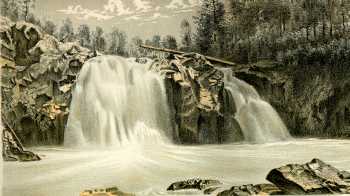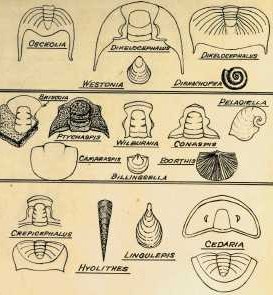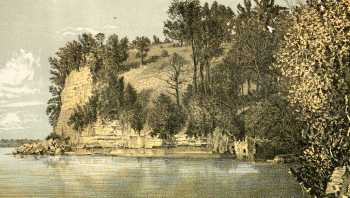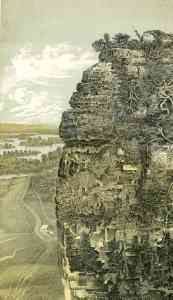
|
Precambrian rocks at the upper falls of the Black River near Superior, Wisconsin
|
|
 The earliest history of Wisconsin is recorded by ancient rocks of Precambrian age. In places over two billion years old, and commonly altered from their original appearance, these rocks represent the deposits of ancient seas, volcanos, and underground bodies of liquid material called magma. They do not contain fossils, and they form the basement on which fossiliferous strata of the Paleozoic Era were deposited. The earliest history of Wisconsin is recorded by ancient rocks of Precambrian age. In places over two billion years old, and commonly altered from their original appearance, these rocks represent the deposits of ancient seas, volcanos, and underground bodies of liquid material called magma. They do not contain fossils, and they form the basement on which fossiliferous strata of the Paleozoic Era were deposited.
|

|
Typical trilobites and other fossils from the Cambrian of Wisconsin
|
|
 About 520 million years ago, during the late part of the Cambrian Period, a shallow inland sea spread across much of Wisconsin. Clastic deposits derived from erosion of land areas covered the bottom of this sea. These deposits are represented by beds of sandstone and shale that contain trilobites and a few other kinds of fossils. About 520 million years ago, during the late part of the Cambrian Period, a shallow inland sea spread across much of Wisconsin. Clastic deposits derived from erosion of land areas covered the bottom of this sea. These deposits are represented by beds of sandstone and shale that contain trilobites and a few other kinds of fossils.
|

|
Bluff containing a contact between Cambrian sandstone (lower part of bluff) and Ordovician dolostone (upper part of bluff) at Lucas Point, Green Lake, Wisconsin
|
|

|
Ordovician Galena dolostone along the Mississippi River near Cassville, Wisconsin
| |
|
 An inland sea persisted across eastern and southern Wisconsin during the following Ordovician and Silurian Periods. For most of its history, this sea received little clastic material, and the sea bottom was covered by carbonate deposits. These deposits are represented by beds of limestone and dolostone that contain corals, brachiopods, crinoids and many other kinds of fossils. Reefs flourished in this sea during the later half of the Silurian Period. During the Devonian Period, the inland sea retreated to southeastern Wisconsin, and by the end of the Devonian, it was gone. An inland sea persisted across eastern and southern Wisconsin during the following Ordovician and Silurian Periods. For most of its history, this sea received little clastic material, and the sea bottom was covered by carbonate deposits. These deposits are represented by beds of limestone and dolostone that contain corals, brachiopods, crinoids and many other kinds of fossils. Reefs flourished in this sea during the later half of the Silurian Period. During the Devonian Period, the inland sea retreated to southeastern Wisconsin, and by the end of the Devonian, it was gone.
|
 For the following 360 million years, Wisconsin was a land area that did not accumulate any permanent sedimentary deposits. This is indicated by the lack of strata of late Paleozoic, Mesozoic, and Tertiary age. For the following 360 million years, Wisconsin was a land area that did not accumulate any permanent sedimentary deposits. This is indicated by the lack of strata of late Paleozoic, Mesozoic, and Tertiary age.
|

|
Schematic map showing the distribution of Pleistocene glaciers in Wisconsin.
|
|
 About one million years ago, during the Quaternary Period (also called the Ice Age), glaciers intermittently covered all but the southwestern corner of the state. The glaciers and their associated river and lake systems left mud, sand and gravel deposits that cover the PreCambrian and Paleozoic rocks. In places, these deposits contain the bones of Ice-Age mammals such as mastodons and giant bison. About one million years ago, during the Quaternary Period (also called the Ice Age), glaciers intermittently covered all but the southwestern corner of the state. The glaciers and their associated river and lake systems left mud, sand and gravel deposits that cover the PreCambrian and Paleozoic rocks. In places, these deposits contain the bones of Ice-Age mammals such as mastodons and giant bison.
|
|
Illustrations on this page (except for trilobite sketches) are from GEOLOGY OF WISCONSIN 1873-1879, volumes I, II, and III.
|






